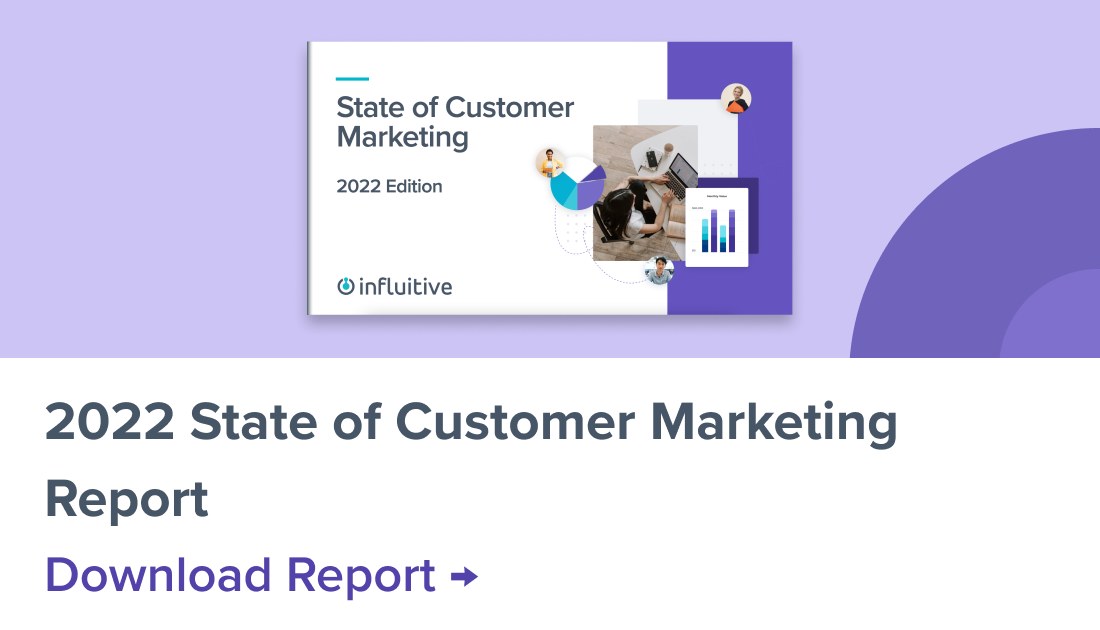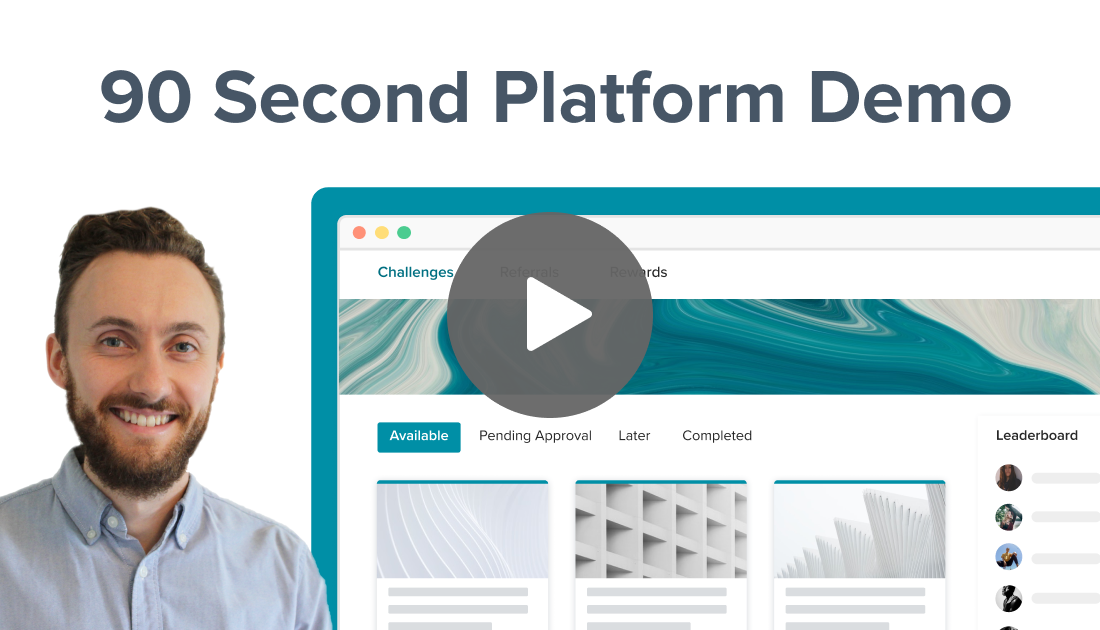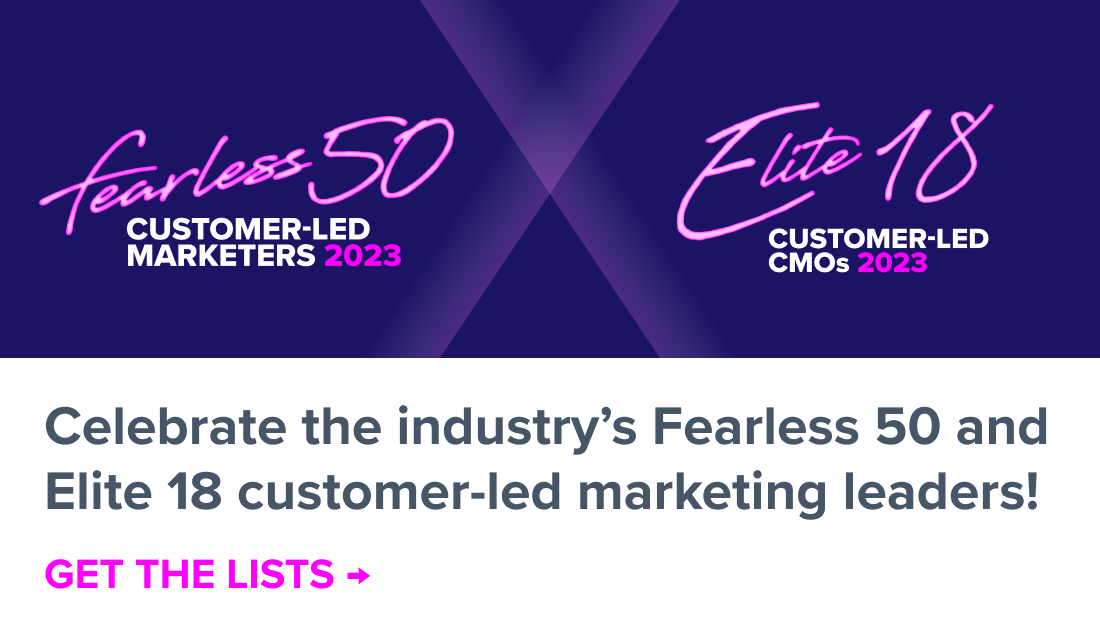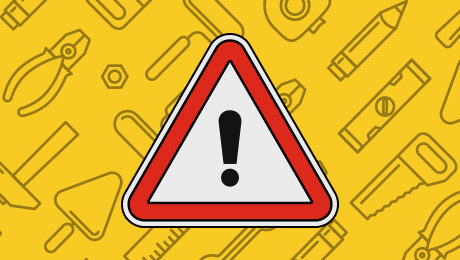The Top 7 Reasons Advocacy Programs Fail (And How To Fix Them!)
by Influitive | May 16, 2018 | Advocacy ROI, Advocate Engagement, Advocate Marketing 101, AdvocateHub Best Practices, Community, Customer Engagement, Retention & Growth, Customer Marketers, Finding Your Advocates, Rewards and Recognition, Uncategorized |
In the 1989 film Field Of Dreams, a disembodied voice talked Kevin Costner into building a baseball field with some of the worst marketing advice of all time:
“If you build it, they will come.”
Success in advocate marketing takes way more than just launching a program. No team of ghostly heroes will materialize to save you. You need to continually engage your advocates and prove value internally.
But with the right strategy and tactics, you can build an engine of genuine advocate interest that takes on a life of its own and pays off handsomely.
Here are the 7 most common reasons advocate marketing programs don’t succeed—read on to learn the best practices to fix them.
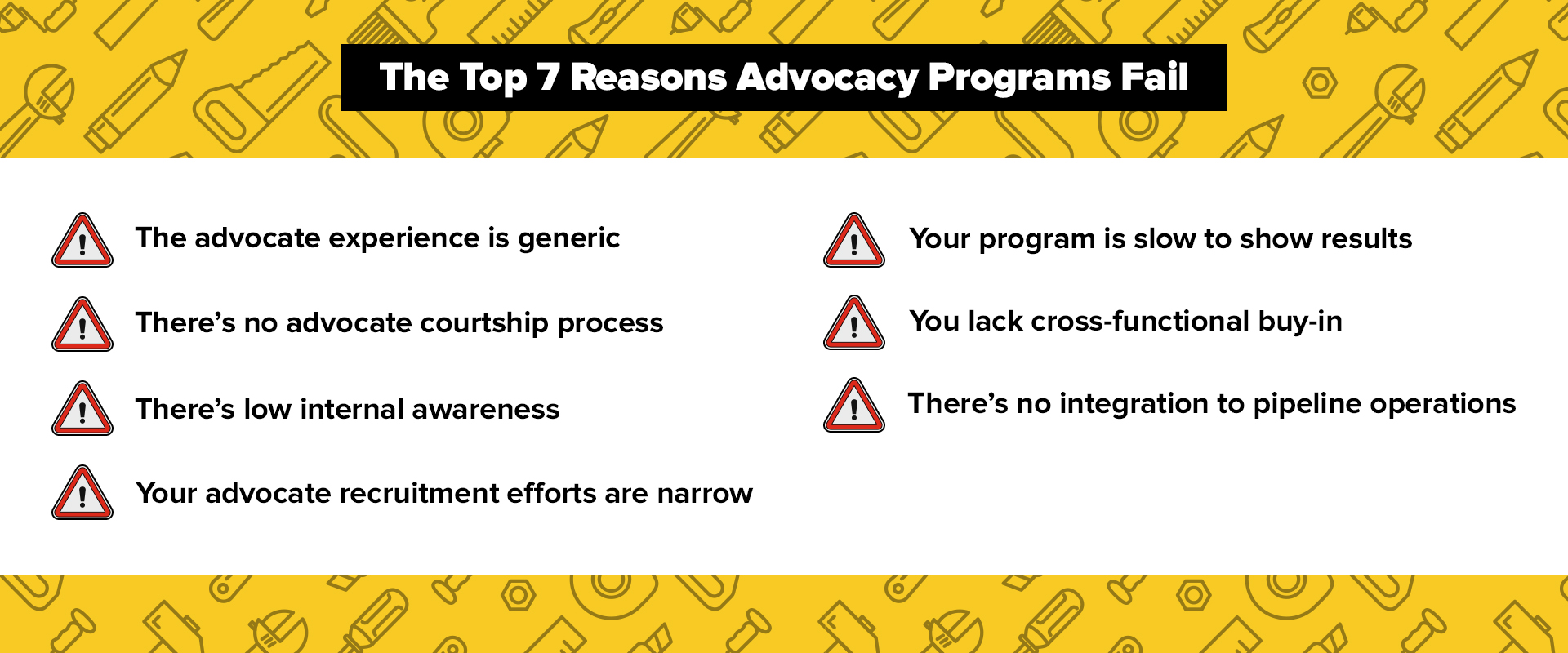
1. The advocate experience is generic
Your advocates are busy professionals, and they have to be judicious about where they spend their time. Unfortunately, many marketers don’t make the effort to personalize their advocacy program for their users. If a customer joins the program and immediately feels “this isn’t for me,” they won’t engage with the program or stick around long term.
For example, if a busy executive logs into your program and only sees content that’s written for end-users, they’re unlikely to participate. Or if a program offers rewards that your users don’t want, it’s unlikely to inspire action (for example, if you were to offer developer advocates an opportunity to meet your head of sales.)
How to fix it: You have to get inside your customer’s head and appeal to their interests. First, tailor your rewards to your industry or vertical, like Cisco did. When their team created Cisco Cert Insiders, they didn’t just offer up random rewards. They offered rewards that would help their audience, mostly IT professionals, advance in their careers, such as exam vouchers and conference passes. The program generated over 36,000 acts of engagement and enjoyed a 58% engagement rate—over double the engagement of Cisco’s other programs.
Another critical element is to segment your customer base into advocate personas. These are like buyer personas, only for existing advocates. They allow you to target your “asks” to the right audience and increase the chance that they’re accepted.
Leaders who want to establish a reputation can participate in speaking opportunities, while those who prefer to be behind-the-scenes can give you product feedback. You can also target your “asks” based on stages in the customer journey, so that everyone can participate in opportunities that make the most sense for them.
The Brand Advocate Persona
In this eBook, learn to extend persona development beyond the buying process in order to understand the different profiles of your customers... and most importantly, understand what motivates some customers to become active advocates for your brand, while others remain disengaged.
Download now!
2. There’s no advocate courtship process
Marketers today are under tremendous pressure to demonstrate ROI. It’s understandable then, that they’d immediately ask new advocates for referrals. But, much like proposing on a first date, this is a recipe for disaster. It will just discourage advocates from participating further.
You need to nurture your advocates (with educational content, networking opportunities, and fun stuff) before you attempt to mobilize them to help you reach your goals. Don’t build your customer relationships on a rocky foundation.
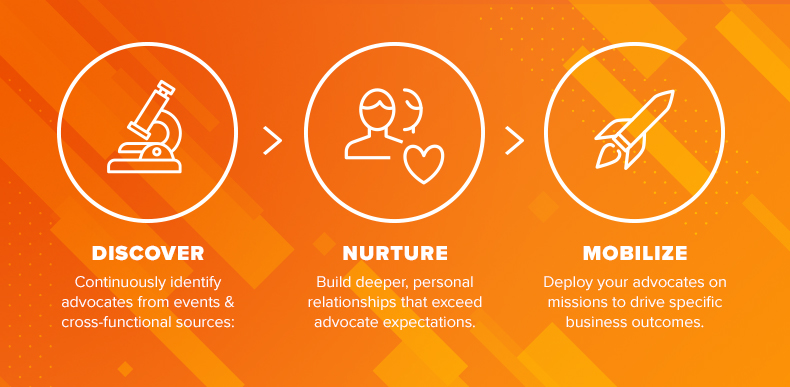
Successful programs discover, nurture, and mobilize advocates.
How to fix it: Advocacy works better than most marketing strategies because it’s powered by real relationships—and there’s no shortcut to becoming friends. Get to know your members by asking questions and encouraging them to build out their profile. Delight them by creating moments that matter.
Make things fun by offering interesting challenges (like MongoDB), develop a mutual respect by asking for their opinions and feedback (like Quickbase), and help them grow by offering learning opportunities (like Marketo).
You can also tailor your program’s rewards to appeal to your advocates. When you give people the stuff, power, access, and status that they want, they’ll be motivated to give back to the community.
With a foundation of trust, you can go public by tagging each other in social media posts and become true partners through references, content, speaking engagements, and of course, referrals.
3. There’s low internal awareness of your advocacy program
As an advocate marketer, your advocates should be your #1 focus. But don’t forget that you still need buy-in and support within your company to make the program a success.
If your sales, customer success, growth, product, and leadership teams aren’t aware of the program, they can’t help. They won’t drive customers to join, won’t benefit from the content that it generates, and won’t bring you potential success stories—making your job that much harder.
How to fix it: Advocacy takes a village. Put as much effort into promoting it internally as externally. Having a team of enthusiastic customer success and sales people pitching the program will give you greater reach. Regularly update your entire company on the program’s successes, and educate them on how it makes their job easier.
For example, you can feed referrals to your sales team, and upsell case studies to customer success managers. You can create an advocacy request form so that it’s easy for others to get involved, and you can write an internal FAQ so everyone knows exactly what the advocacy program is for.
4. Your advocate recruitment efforts are narrow
Attrition of your program members will happen naturally as advocates change roles and jobs, so you need to be proactive about counteracting this with fresh advocates. But if you’re just relying on marketing campaigns to recruit new advocates, you’re missing a lot of major opportunities to grow your program.
Plus, if you aren’t continually increasing your advocacy program membership, you aren’t providing your advocates a new infusion of people, thoughts, and insights. You need to keep things fresh with a continuous stream of new advocates.
How to fix it: Consider multiple intake channels for new recruits, by partnering with other departments in your organization.
Here are some ideas to get you started:
- Encourage sales reps to invite new customers into your advocate program after they close a deal
- Get your CSMs to invite in advocates from their most engaged and enthusiastic accounts
- Include a link to join the program in NPS follow-ons
- Invite customers to join at user group meetups
- Prompt your Partners to refer customers into the program
- Work with your product team to put CTAs to join your advocate community directly within your software product
You can also announce the program at your sales kick-off and offer spiffs to your customer-facing teams to encourage them to recruit new advocates, or win back old ones who churned because they changed jobs.
5. Your program is slow to show results
Marketers, advocates, and anyone involved in an advocate program are occasionally guilty of chasing shiny objects.
That’s why if you don’t establish initial momentum and demonstrate results to everyone involved, it can lose steam. At the same time, doing it irresponsibly and trying to drive revenue immediately can lead to bad behavior (see #2). Teams that don’t strike the right balance between early wins and making advocates happy will find that their programs run flat.
How to fix it: Choose 2-3 quick wins for your advocacy program, while you build the foundation to eventually achieve more ambitious outcomes.
Cement your early successes by encouraging advocates to do things that are highly visible, such as speaking at events, giving product input, and contributing content. These stories will spread within your company and show results without you having to pressure advocates into referrals before they’re ready.
At the same time, start collecting and sharing data to prove ROI. This can be both how advocacy drives pipeline (e.g. referrals, references, reviews), and how it helps avoid costs (e.g. content, market research, events.)
How to calculate the ROI of advocate marketing
Learn how to measure and track the value of advocate marketing—and prove to your entire company that it’s worth the investment. This guide features insights from marketers at companies like BMC Software, Ceridian, Iron Mountain, ReadyTalk and more.
Download now
6. You lack cross-functional buy-in
When marketers create their advocacy program without consulting others, several things go wrong. First, they don’t benefit from a diversity of perspectives. If executives in other departments get to participate, they’ll have a chance to suggest changes that benefit them (and this will give them good reason to support the project.)
And second, people simply like things better when they have a hand in creating them. The behavioral economist Dan Ariely calls this the IKEA effect. If we have to assemble our own bookshelf, we value it much more highly than if we simply purchased it. And it’s the same in business. If an advocate marketing program springs up without our input, we’re less likely to be receptive than if we had been included in planning it.
How to fix it: Establish a monthly advocacy committee with cross-functional representation. This will help you make sure it delivers value to every part of the organization and helps you unify each department’s “asks” into a singular customer experience.
It also makes all department heads feel invested and helps ensure their support. After all, it was their idea, wasn’t it?
Some of the most important teams to align your advocate marketing program with are your sales team, CS team, and product team.
7. There’s no integration to pipeline operations
No advocacy program is an island and if you treat yours like one, it may flounder. Companies that don’t successfully integrate advocacy into driving pipeline and measuring it within the first twelve months have a hard time ever reaching that point. (Check out this blog if you want to know how to start setting this up.)
How to fix it: While you’re still building trust with advocates and priming them for revenue-generation activities like referrals and influencing deals, tackle the IT component of connecting your advocacy software into your marketing system. (Sometimes it’s a simple integration.)
That way, you’re tracking revenue-generation activities from day one. And when pipeline starts to flow, you can announce it and rally everyone around the program’s ROI benefits.
One Influitive customer integrated AdvocateHub with their CRM and marketing system and was able to see that one advocate influenced $32 million in pipeline and $11 million in closed revenue.
It’s time to go to bat
When advocacy programs work, the payoff is enormous. But it takes effort. Teams must invest their energy into thinking about how it will be unique, how they’ll court new members, and how they’ll collaborate with other teams.
And if they do, they’ll build an advocacy program that attracts and retains excited advocates who help them realize their goals, including ROI.
So, don’t just build it and wait for them to come. Grab your helmet, get out there, and go to bat.
Subscribe to Influitive's advocate marketing blogEnter your email address now to receive the latest advocate marketing resources delivered right to your inbox every month! You can withdraw your consent at any time.









